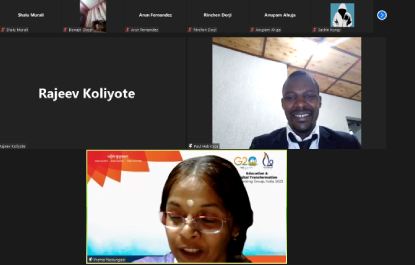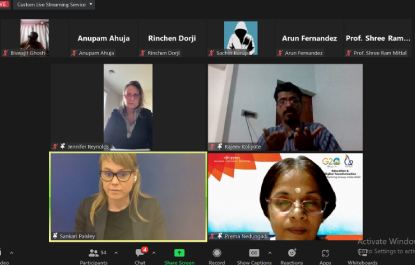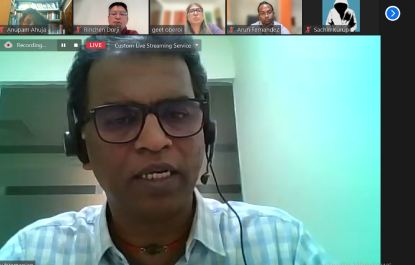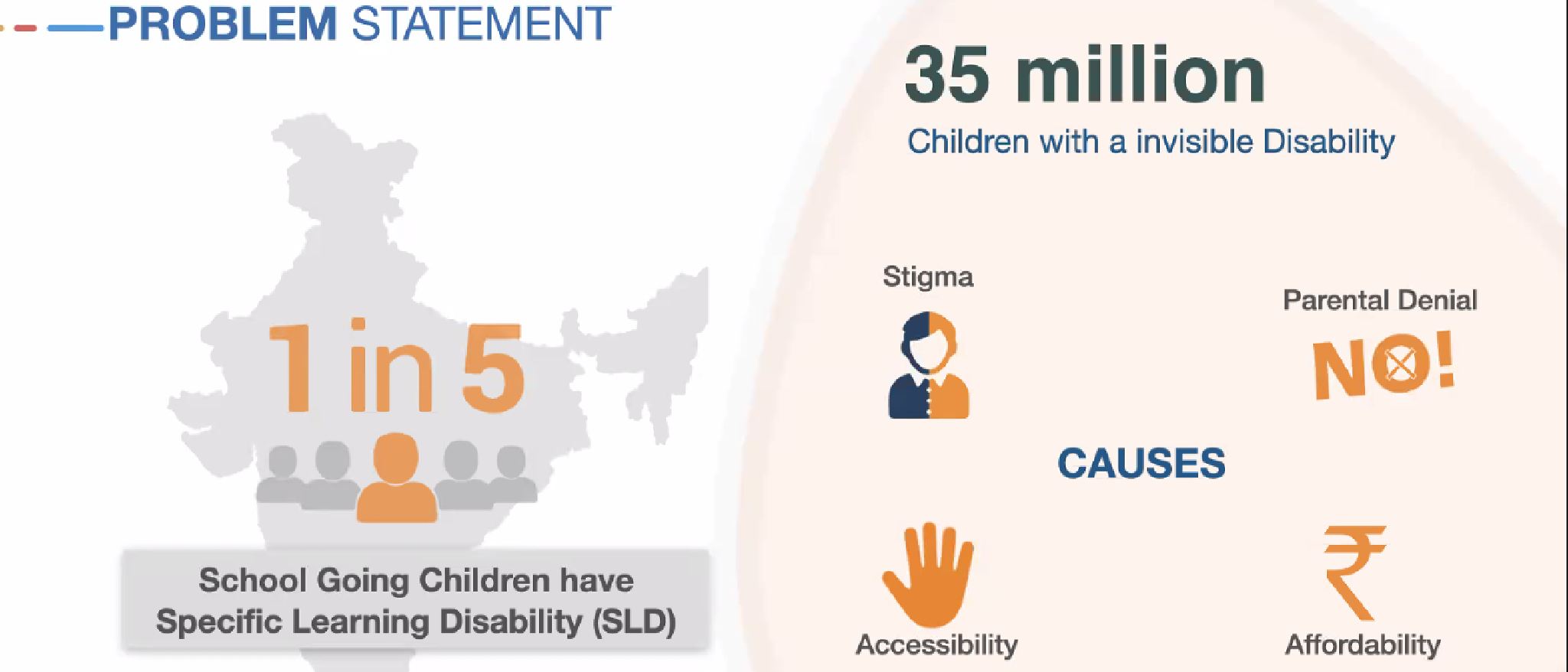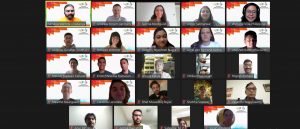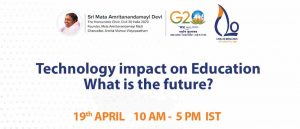A webinar on the theme Technology for Education, Communication for Persons with Disability was organized by the Education and Digital Technology working group on March 14, 2023. The event brought together eminent speakers representing CSOs to share their perspectives on employing technology for communication for people with disabilities. Over 185 participants representing 14 countries, including the UK, the USA, Togo, Ghana, Pakistan, Anguilla, and Kuwait, attended the virtual event.
C20 EDT Coordinator Dr. Prema Nedungadi, Director Amrita CREATE, and School of Computing Amrita Vishwa Vidyapeetham, Amritapuri, said that persons with disabilities are always the first to be affected during different contexts. For this reason, it is imperative to find technological solutions that help address the various barriers and challenges faced to bridge gaps toward achieving equity. Dr. Nedungadi invited the panelists to share their recommendation and the key barriers to implementation.
Dr. Anupama Ahuja is the Head of the Department of International Relations at NCERT. Dr. Ahuja has extensive experience in Special Education. She highlighted the special education guidelines framed to provide equitable opportunities and inclusive education to all children with the objective that all students study under one roof together. According to her, this approach helps create a friendly learning environment. She adds that a common thread across SDG 4, Quality Education; NEP 2020; and RPwD Act 2016, is equitable opportunities and inclusive education for children.
Based on research, at the global and national, lack of accessible learning materials acts as a major barrier to education. Next, she highlights that students outside the school system must be considered. Inclusion my include children with disabilities since, “The children who learn together, learn to live together. So it’s also working towards building inclusive.” She adds that the guidelines are based on four cardinal principles based on Universal Design for Learning (UDL): inter-link components of accessible e-Content (technology, content, and pedagogy); guidelines for academic and non-academic content; provide linking activities and content in textbooks; and text content with target group.
Shankar Subbiah is an Assistive Technology and Accessibility consultant at Agate Infotek. He is passionate about developing solutions that facilitate people with disabilities living independently. While he pointed out that customization of ICT to meet specific needs is possible, affordability remains a barrier. He said stakeholders’ involvement and lobbying for policy implementation are essential and can make a significant difference. He added that teachers and other individuals working with children with disabilities need training in these tools, and awareness must be created. He recommended addressing roadblocks and delays in the procurement procedures since it serves as a major hurdle while scaling indigenously developed technological solutions.
Paul Habineza is a researcher at Commonwealth Social Education and an advisor of JET Education, Rwanda. He outlined that awareness is the key to encouraging the use of technology to empower disabled people. Additionally, the organizations he is associated with focus on conducting training sessions and awareness programs. He added that the government and NGOs, with community support in terms of funding and research, can bolster efforts to frame laws to address the need for inclusive education. The media, according to him, can strengthen this effort.
Biswajit Ghosh, the director of Arunodaya Foundation, Ek Kadam Aur Foundation for Education and Health, shared his lived-experience as a blind person. He said that societal support and attitudinal change, particularly in schools, are essential to support blind children. He said early intervention for blind children is necessary, and they must learn braille early. Sharing insights on the impact of the Covid-19 pandemic, he said that children with visual impairments suffered since they could not connect and use digital devices. Highlighting the importance of technology, he said that adequate resources and training teachers on Braille technology are the need of the hour.
Dr. Geeta Oberoi is the Founder and President of Orkids Education Systems. With over 25 years of experience in Specific Learning Disabilities, she outlined her top four priority areas as lack of screening tools; lack of awareness; lack of accountability at schools; and lack of trained professionals, special educators, psychologists, and psychiatrists. She emphasized the need for early screening to identify at-risk children.
Dr. Oberoi emphasized on the advantages of early intervention since it it can bring children who have dropped out into the mainstream as soon as possible. She questions why the prescribed screening age was eight and not earlier, one of the recommended recommendations. Additionally, she said that a technological screening tool that teachers can use could help early identification of children and empower teachers.
Jennifer Reynolds is an American, and her native language is American Sign Language (ASL). She was educated in the mainstream system utilizing ASL interpreting services. She works at Lexington School, New York, as a teacher assistant, in general education and serves as an ASL teacher at the high school level. Highlighting some of the technologies that can be used for deaf people include Video Remote Interpreting (VRI) and Voice Recognition Systems (VRS). She added that there are several tools for communication and real-time translation but highlighted the need for interpreter services. Communication Access Real-Time Translation (CART) was another suggestion shared.
Staci Paisley is an American Sign Language interpreter with extensive experience in different settings. From an interpreter’s perspective, she said that raising awareness in the community about the deaf culture and the necessity of sign language is essential. Se adds early diagnosis and development of sign language exposure to young children is equally important as interpreting services since it helps in cognitive development at the school with sign language technology. Another aspect she mentioned is technological development.
Dr. Rinchen Dorji is the President of Samste College of Education, Royal University of Bhutan. Dr. Dorji shared his experience as a teacher and teacher educator in the Bhutan education system. He explained that Bhutan witnessed tremendous educational growth and development, especially in inclusive initiatives and addressing the needs of children with disabilities. He said, “The awareness of persons with disabilities and the need to address their educational needs in mainstream school” alongside learners without disabilities is imperative. Collaboration with stakeholders and international development partners to optimize the benefits of technological advancement and digital transformation is critical to building an inclusive education ecosystem in Bhutan.
Arun Fernandez founded DLearners, an organization that promotes Dyslexic Thinking. He pointed out that awareness related to Dyslexia in tier three and tier four cities were less. Sensitizing parents, children, and educators about specific learning difficulties is crucial since early intervention can help the child build confidence. He recommended systemic change through policy changes, where children were to be screened at school, making the process less intimidating and de-stigmatizing the process. He added that reasonable accommodations must be provided to students.
Based on his lived experience with Dyslexia, he has developed a content aggregator platform making learning resources available to promote Dyslexia Thinking and engaging with learning materials differently. Children at risk of dropping out need to be identified; governmental support is required to achieve this. He added that while children attend school, they can receive remediation or support from special educators using assistive technology tools or platforms. In this way, teachers can connect with students and provide support since it may not be possible to give individualized support in a mainstream classroom since educators handle large class sizes.
The deliberations led to sharing ideas, experiences, and policy recommendations.
